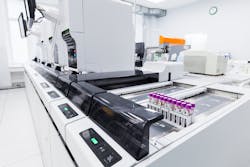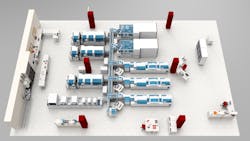The effort to lower costs, increase efficiency, and improve patient care continues to drive clinical laboratory automation. At Mayo Clinic, automation is embraced across our campuses, from the lab to the lawn and in other day-to-day routines including food service deliveries and supply chain. In the clinical lab, our laser focus on optimizing automation began more than 10 years ago and has continued as we leverage our own experience and technology developments. We envision that more and more areas within the Department of Laboratory Medicine and Pathology will benefit from automation as more automated analytics processes in mass spectrometry become reality, replacing costly, manual processes and supporting specialized expertise.
This article offers an overview of how two groups of clinical laboratories at our Mayo Clinic campus in Rochester, Minnesota, leverage automation to meet the increasing demand for timely, high-quality results in an environment of rapidly evolving technology. One group encompasses the Central Processing area, which receives and processes 12,000–15,000 patient specimens a day, and the Central Clinical Laboratory, with a volume of more than 6 million tests a year. The second group includes the Clinical Mass Spectrometry Laboratory, the Clinical and Forensic Toxicology Laboratory and the Metals Laboratory, with a combined volume of about 3.5 million tests a year. Both groups of labs serve local Mayo Clinic patients and Mayo Clinic Laboratory clients worldwide, with an estimated 15% of the patient testing volume coming from outside the United States.
Automation: Where we are today
Automation was first implemented in our Central Processing area and Central Clinical Lab in 2009 and underwent a major update in 2019 to encompass greater functionality into our total lab automation (TLA) solution. Automation has been critical in enabling us to serve physicians and patients at Mayo Clinic by processing a large volume of specimens, including blood, urine and other body fluids. Two-thirds of patient blood specimens arriving in Central Processing are analyzed in the Central Clinical Lab, with a test menu that includes chemistry, immunochemistry, coagulation and hematology. Figure 1 provides an overview of our total laboratory automation. The automation line covers pre-analytics and chemistry and immunoassay analyzers, as well as hematology and post-analytic refrigerated storage units. With post-analytic refrigeration and storage, we can eliminate the steps involved in manually archiving and retrieving specimens when additional testing is needed.
Our 2019 update was prompted by the availability of new technology, ever-increasing test volumes, staffing challenges and, to a lesser degree, a growing test menu. Key to this update was the consolidation of two automation lines into one, further streamlining workflow and improving efficiency. This included the integration of Roche cobasconnection modules, cobas 8000 modular analyzers, Sysmex XN-9100, and cobas p701 post-analytic storage/retrieval.Our second group of labs—including Clinical Mass Spectrometry, Clinical and Forensic Toxicology, and Metals—has a broad test menu that includes therapeutic drug monitoring (TDM), endocrine and hormone testing, vitamins, drugs of abuse, controlled substances, clinical toxicology, forensic toxicology, trace elements, and heavy metals. Mass spectrometry is a key methodology within Mayo Clinic and encompasses dozens of mass spectrometers coupled to high performance liquid chromatography and gas chromatography, along with Fourier-transform infrared spectroscopy (FT-IR), and inductively coupled plasma (ICP) mass spectrometry. Of note, the test menu includes more than 2,000 laboratory-developed tests (LDTs). Automation presently is focused on pre-analytics—from the primary tube all the way to the 96-well plates, a standard specimen entry point for mass spec and many other analyzer platforms. Pre-analytical automation, as set up in our labs, is important not only in addressing labor shortage and increasing throughput, but also in increasing accuracy and precision with robotic liquid handling. The valuable staff time freed up by automation is one contributing factor in supporting menu expansion as well as increased test volume.
Getting the most out of automation
Bringing total lab automation online is just the beginning. Our ongoing efforts strive to optimize our processes in order to achieve even greater efficiency. The following are key areas we focus on to reap the greatest benefit possible from our automation solutions.
Digital solutions: We rely heavily on data and analytics and use data to drive improvements. One example is rule-based logic for decisions such as whether a specimen needs to be further investigated, or a test result requires additional quality checks. This logic resides in cobas infinity, the customizable middleware solution we have used to create specific workflows based on our lab’s needs, which reliably triggers intervention by the technologist when needed.
An example where Mayo has pushed care for patients forward for digital solutions is our AI-enabled kidney stone algorithm, as demonstrated in a recent initiative to apply AI in kidney stone FT-IR spectra analysis. Drawing on our database of more than 1 million kidney stones in our kidney stone FT-IR spectra library, AI algorithms were developed and validated, and their interpretations were compared with technologist interpretations. A comparison based on spectra data from >80,000 kidney stones showed an overall clinical concordance of 90% between technologist and algorithm. Importantly, the AI-augmented workflow allows the lab to “identify and correctly report kidney stone constituents at a higher rate, which is crucial for treatment and recurrence prevention in the stone-forming patient.”1
Informatics: Customizing and fine-tuning workflows can result in operational benefits, but it is important to assess if the desired outcome is being achieved. Laboratories need tools that easily and reliably provide critical laboratory data such as test result turnaround times, specimen rejection rates, and other quality metrics. We are working with our colleagues in the Division of Computational Pathology and Artificial Intelligence to assess newer tools with broader capabilities, such as navify Analytics.
Next, we will take a close look at how this works in real time—i.e., assessing the frequency at which these rules are fired, and understanding the types of specimens and patterns of specimens that trigger the system to preempt auto-verification. These insights will allow us to adjust the underlying rules and optimize the process. Another example is taking a closer look at workflow—identifying windows where we are running at close to capacity, versus lulls—again looking for ways to streamline and optimize.
Specimen collection and handling: The ability of the new automation system to accept a multitude of different tube types has eliminated the need for manual presorting—saving staff time and time to results. Even more important is the ability of our automation line to handle a multitude of different specimen tube sizes. This enables us to collect only the amount of blood that is needed for the tests ordered, rather than the same specimen tube size for all patients, all tests. Because of the preanalytic automation’s ability to handle multiple blood tube sizes, we have recently observed a 50% reduction in the volume of blood required for testing on the system. This is a change that is a significant improvement for pediatric patients and patients requiring frequent blood draws.
Thoughtful change management
The transition toward total lab automation, like any change, can create uncertainty and perhaps concern among the staff as their roles are redefined. We have found it beneficial to have a concrete plan to prepare our team by sharing specifics about the upcoming transition toward automation, and how this will enable each individual’s transition from manual tasks to more skilled and potentially more rewarding work—in decision making, troubleshooting, consulting. All of this can energize the team and pave the way to greater job satisfaction. Once we start laying the groundwork for change management, we can focus on training—familiarizing the staff with new technologies, how their workday may change, and best practices.
A perspective on quality
An important insight that we have gleaned from our experience is the elevated role of quality in a future of ever-increasing levels of automation. Automation is often associated with reduced human errors and the consistency and precision that robotics and computers can enable. But the high testing volume and the speed at which results are delivered also mean that problems can be rapidly multiplied, and along with that, the impact on patient care. The solution lies, in part, in making sure that processes are in place to detect issues quickly and enable just as rapid recovery from errors.
Partnership and collaboration
Our Central Clinic Lab has a collaborative relationship with a trusted vendor partner — Roche Diagnostics, which plays a key role in designing, configuring and installing the system; preparing, engaging, and training our team; and providing the ongoing technical and service support. Over the past 15 years, as our automation line has evolved, with more functionalities, interactivity, and complexity, our partnership has also evolved, and their field application specialists and field engineers have become familiar with our processes and therefore our needs as end users. In fact, we often think of their service engineers as honorary members of our lab.
Another key resource is our IT team, which has played and continues to play a critical role in approvals, validations, security, and all things IT. At our campus here, we are blessed with a team of information management specialists and coordinators many of whom, in addition to their specialized knowledge, began their careers in the laboratory and thus have insights from firsthand experience in a lab environment.
Commitment to continuous improvement and innovation
Total lab automation has benefited our Central Processing Lab in cost containment, efficiency improvement, and, most importantly, quality patient care. Currently, pre-analytic automation is utilized in our Clinical Mass Spectrometry Laboratory, but we see opportunities for greater automation of key or routine assays in the near future. This increased level of automation would be especially beneficial given mass spectrometry’s powerful analytic processes, as reflected in the higher sensitivity and specificity compared with immunoassays. However, it is significantly more complex and mainly associated with larger labs with complex instrumentation and specially trained personnel using primarily LDTs. Mass spec automation will especially benefit high-volume tests such as TDM and tests that require rapid turnaround times, and perhaps near-patient testing. As we look to the future of total lab automation across our Mayo Clinic campus, we are reminded of our primary value: The needs of the patient come first. And this primary value continues to motivate us to leverage technological innovations for automation and, ultimately, the highest quality patient care.
References
1. Day PL et al. Artificial intelligence for kidney stone spectra analysis: Using artificial intelligence algorithms for quality assurance in the clinical laboratory. Mayo Clin Proc Digital Health 2023;1(2):1-12. https://www.mcpdigitalhealth.org/article/S2949-7612(23)00002-0/fulltext.
About the Author

Nikola Baumann, PhD, DABCC
is Co-Director of the Central Clinical Laboratory and Central Processing Laboratory, Director of the Process Innovation Through Automation (PITA) Laboratory, Co-Director of the Biospecimen Program, and Vice-Chair of Quality in the Department of Laboratory Medicine and Pathology at the Mayo Clinic in Rochester, MN.

